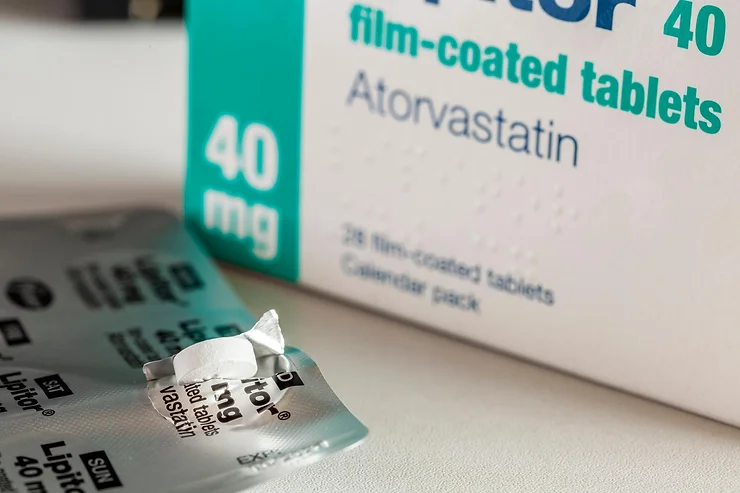
In January 2019 GoodRx.com published an online article[1] entitled, “7 Common Myths about Atorvastatin.” In this article Dr. Sharon Orrange at the Keck School of Medicine of USC (University of Southern California) minimized the adverse effects of Atorvastatin almost like a pharmaceutical representative would do. Let me clarify the facts.
The myths, the excuses, and the facts She begins by defending Atorvastatin by writing it… “is great at lowering cholesterol but often gets a bad rap.” First off, it's lowering heart disease risk that you and I are concerned with, not lowering cholesterol. We know that in 2009 it was revealed by the American Heart Journal that nearly 75% of patients who are hospitalized for a heart attack have LDL cholesterol levels within the recommended target for LDL cholesterol.[2] Moreover, researchers of the Framingham Heart Study tell us that “Total cholesterol was not associated with the risk of coronary heart disease”[3] and a 1994 JAMA article[4] reported that hypercholesterolemia or low HDL-C are not important risk factors for deaths by a heart attack in persons over age 70 years.
Her next comment did not make much sense to me. She explains that muscle pain, cramps, diarrhea, and upset stomach are some of the known adverse reactions to Atorvastatin and that approximately 50% of Atorvastatin takers quit taking it within 6 months…due to side effects. Not reassuring for sure. Even though 60% of those 50% restart it later, side effects are still quite high.
She then addresses other “rumored side effects of atorvastatin” as she plays them down.
“Atorvastatin causes cancer” is clearly a myth and hardly mentionable
“Atorvastatin is bad for your liver” is clearly a possibility: liver enzymes rise in 0.5-3% of patients taking the drug. Know that liver enzymes rise as a late (not early) manifestation of damage to your liver. Symptoms manifest long after the disease has progressed, not at the onset.
“Atorvastatin causes joint pain or arthritis” in 9-12% of takers and “we’re not sure why that is.” She offers a weak explanation: “…one theory is that joint aches are more common in older folks who also happen to take more statins.” Remember the 1994 JAMA article[5] I reported earlier which reported that high cholesterol or low HDL-C are not important risk factors for death by heart attack in persons over age 70 years. So, why prescribe them in the elderly? What’s more, she quietly inserts that muscle aches occur in 48% of takers! This is certainly not a “rumored side effect.” This is a major concern and reason for discontinuation of the drug!
“Atorvastatin causes depression.” She wrongly asserts, “Atorvastatin is not associated with an increased risk of suicide or depression.” To the contrary, there is growing evidence that statins may actually cause depression, as cholesterol itself plays an important role in neuroprotection. The authors of a 2013 review of the literature[6] concluded that in clinical practice, “we should be alert to the risk of mood disturbance in the increasing number of patients receiving lipid-lowering therapy, especially in patients with depressive tendencies or patients with normal or low serum cholesterol level.” For example, the more lipophilic statins simvastatin and lovastatin have been associated with depression.[7]
“Atorvastatin causes sleepiness, headaches or rash/hives.” True, yet how about we focus on the more serious adverse effects that are not just “rumored side effects.”
Not just rumored side effects
Beatrice Golomb, MD, PhD, associate professor of medicine at the University of California, San Diego (UCSD) School of Medicine and director of UC San Diego’s Statin Study group[8] has reportedly cited nearly 900 studies on the adverse effects of statins in various published articles. The adverse effect that is certain is that statins damage mitochondrial function.
In her 2008 article published in the American Journal of Cardiovascular Drugs[9] Dr. Golomb gives scientific evidence that statins lower the anti-oxidant Coenzyme Q10 (“Q10”) in your body through the same pathway that they lower blood cholesterol and thereby damage mitochondrial function. Mitochondria are our energy-producing cells, which control harmful molecules called oxygen free radicals.
Furthermore, aging and chronic illness correlate with fewer and weaker mitochondria, Therefore, the longer you take a statin drug the more you’ll worsen chronic illnesses. The manufacturers and studies show that the risk of statins is worse than its benefit in patients over the age of 75 years, even in those with known heart disease.
Dr. Golomb shows that by damaging your mitochondria, statins contribute primarily to the following:
Cognitive problems, behavioral and emotional disorders, chronic nerve and muscle damage, and even neuromuscular degeneration (much like Amyotrophic Lateral Sclerosis, a.k.a. ALS) are all reported from taking statins. Some have even reported memory loss or confusion after taking statins.
Peripheral neuropathy (pain or numbness in the extremities): Thousands of statin users have reported peripheral neuropathies, and there is a tendency toward resistance to all traditional medical treatments for this.
Blood glucose elevation or type 2 diabetes may increase when you take a statin.
Safer alternatives to statins Indeed, there are safer alternatives to statins for cardiovascular disease risk reduction. I have written previously in more detail on this. Here are those highlights summarized:
First eliminate these more dangerous risk factors: persistent uncontrolled hypertension, uncontrolled diabetes mellitus, tobacco smoking, and excessive visceral adipose tissue (VAT), a.k.a. belly fat
Nutrient-rich foods[10]
Exercise[11] [12]
Stress management[13] [14]
Teeth and gum health[15]
Amla; safer and as effective as statins[16] [17] [18] [19]
Thyroid gland functional balance[20] [21] [22] [23]
Testosterone balance[24] [25]
To long-term health and feeling good,
Michael Cutler, M.D.
[1] https://www.goodrx.com/blog/7-common-myths-about-atorvastatin/ [2] Sachdeva A, Cannon CP, Deedwania PC, Labresh KA, Smith SC Jr, Dai D, Hernandez A, Fonarow GC. Lipid levels in patients hospitalized with coronary artery disease: an analysis of 136,905 hospitalizations in Get With The Guidelines. Am Heart J. 2009 Jan;157(1):111-117.e2. Online at: https://www.ncbi.nlm.nih.gov/pubmed/?term=136%2C905+patients%2C+2000+and+2006 [3] Gordon T, Castelli WP, Hjortland MC, Kannel WB, Dawber TR. High-density lipoprotein as a protective factor against coronary heart disease. The Framingham Study. Am J Med. 1977 May;62(5):707-14. PubMed PMID: 193398. Find online at: https://www.ncbi.nlm.nih.gov/pubmed/193398/ [4] Krumholz HM, Seeman TE, Merrill SS, Mendes de Leon CF, Vaccarino V, Silverman DI, Tsukahara R, Ostfeld AM, Berkman LF. Lack of association between cholesterol and coronary heart disease mortality and morbidity and all-cause mortality in persons older than 70 years. JAMA. 1994 Nov 2;272(17):1335-40. Find online at: https://www.ncbi.nlm.nih.gov/pubmed/?term=Lack+of+Association+Between+Cholesterol+and+Coronary+Heart+Disease+Mortality+and+Morbidity+and+All-cause+Mortality+in+Persons+Older+Than+70+Years [5] Krumholz HM, Seeman TE, Merrill SS, Mendes de Leon CF, Vaccarino V, Silverman DI, Tsukahara R, Ostfeld AM, Berkman LF. Lack of association between cholesterol and coronary heart disease mortality and morbidity and all-cause mortality in persons older than 70 years. JAMA. 1994 Nov 2;272(17):1335-40. Find online at: https://www.ncbi.nlm.nih.gov/pubmed/?term=Lack+of+Association+Between+Cholesterol+and+Coronary+Heart+Disease+Mortality+and+Morbidity+and+All-cause+Mortality+in+Persons+Older+Than+70+Years [6] You H, Lu W, Zhao S, et al. The relationship between statins and depression: a review of the literature. Expert Opin Pharmacother. 2013;14(11):1467-1476. https://www.ncbi.nlm.nih.gov/pubmed/23767773 [7] Mailman T, Hariharan M, Karten B. Inhibition of neuronal cholesterol biosynthesis with lovastatin leads to impaired synaptic vesicle release even in the presence of lipoproteins or geranylgeraniol. J Neurochem. 2011;119(5):1002-1015. https://www.ncbi.nlm.nih.gov/pubmed/21899539 [8] https://ucsdnews.ucsd.edu/archive/newsrel/health/01-09Golomb.asp [9] Golomb BA, Evans MA. Statin adverse effects: a review of the literature and evidence for a mitochondrial mechanism. Am J Cardiovasc Drugs. 2008;8(6):373-418. Review. PubMed PMID: 19159124. https://www.ncbi.nlm.nih.gov/pubmed/19159124 [10] Key TJ, Thorogood M, Appleby PN, Burr ML. Dietary habits and mortality in 11,000 vegetarians and health conscious people: results of a 17 year follow up. BMJ. 1996 Sep 28;313(7060):775-9 [11] Neil M Johannsen, Elisa L. Priest, et al. Association of White Blood Cell Subfraction Concentration with Fitness and Fatness. BJSM Published Online First: 17 October 2008. Found online at: http://bjsm.bmj.com/content/early/2008/10/17/bjsm.2008.050682.abstract [12] Stampfer MJ, Hu FB, Manson JE, et al. Primary prevention of coronary heart disease in women through diet and lifestyle. N. Engl. J. Med. 2000 Jul 6; 343(1):16-22. [13] Denollet J, Brutsaert DL. Reducing emotional distress improves prognosis in coronary heart disease: 9-year mortality in a clinical trial of rehabilitation. Circulation. 2001 Oct 23;104(17):2018-23. [14] Denollet J, Pedersen SS, Ong AT, Erdman RA, Serruys PW, van Domburg RT. Social inhibition modulates the effect of negative emotions on cardiac prognosis following percutaneous coronary intervention in the drug-eluting stent era. Eur Heart J. 2006 Jan;27(2):171-7. Epub 2005 Oct 24. [15] de Oliveira C, Watt R, Hamer M. Toothbrushing, inflammation, and risk of cardiovascular disease: results from Scottish Health Survey. BMJ. 2010 May 27;340:c2451. [16] Antony B, Benny M, Kaimal TN. A Pilot clinical study to evaluate the effect of Emblica officinalis extract (Amlamax™) on markers of systemic inflammation and dyslipidemia. Indian J Clin Biochem. 2008 Oct;23(4):378-81. PubMed PMID: 23105791. https://www.ncbi.nlm.nih.gov/pubmed/?term=23105791 [17] Khanna S, Das A, Spieldenner J, Rink C, Roy S. Supplementation of a standardized extract from Phyllanthus emblica improves cardiovascular risk factors and platelet aggregation in overweight/class-1 obese adults. J Med Food. 2015 Apr;18(4):415-20. PubMed PMID: 25756303. https://www.ncbi.nlm.nih.gov/pubmed/?term=25756303 [18] Gopa B, Bhatt J, Hemavathi KG. A comparative clinical study of hypolipidemic efficacy of Amla (Emblica officinalis) with 3-hydroxy-3-methylglutaryl-coenzyme-A reductase inhibitor simvastatin. Indian J Pharmacol. 2012 Mar;44(2):238-42. PubMed PMID: 22529483. https://www.ncbi.nlm.nih.gov/pubmed/?term=22529483 [19] Usharani P, Fatima N, Muralidhar N. Effects of Phyllanthus emblica extract on endothelial dysfunction and biomarkers of oxidative stress in patients with type 2 diabetes mellitus: a randomized, double-blind, controlled study. Diabetes Metab Syndr Obes. 2013 Jul 26;6:275-84. PubMed PMID: 23935377. https://www.ncbi.nlm.nih.gov/pubmed/?term=23935377 [20] von Eiselsberg, AF: “On the Vegetative Disturbances in Growth of Animals after Early Thyroidectomy,” Archives Klinik Chirurgie, 49:207, 1895 [21] Pick, EP, Pineless, F: “Research on the Physiologically Active Substance of the Thyroid,” Exp Path Ther 7:518, 1910 [22] http://easyhealthoptions.com/thyroid-disease-part-iii/ [23] Barnes, Broda O: Solved: The Riddle of Heart Attacks, Robinson Press, Fort Collins, CO, 1976 [24] Nettleship JE, Jones RD, Channer KS, Jones TH. Testosterone and coronary artery disease. Front Horm Res. 2009;37:91-107. Found online at: http://www.ncbi.nlm.nih.gov/pubmed/19011291 [25] Morris PD, Channer KS. Testosterone and cardiovascular disease in men. Asian J Androl. 2012 May;14(3):428-35. Found online at: http://www.ncbi.nlm.nih.gov/pubmed/22522504








